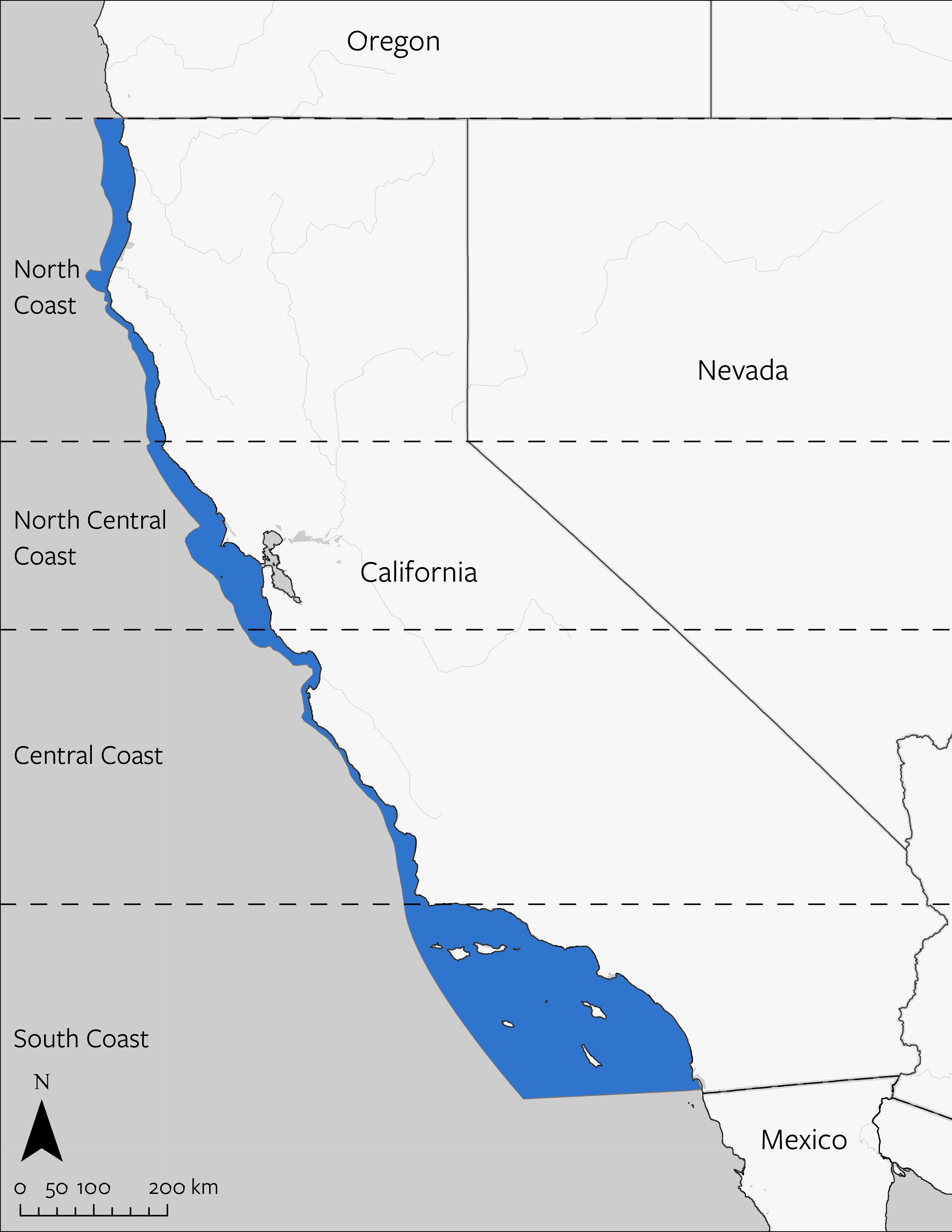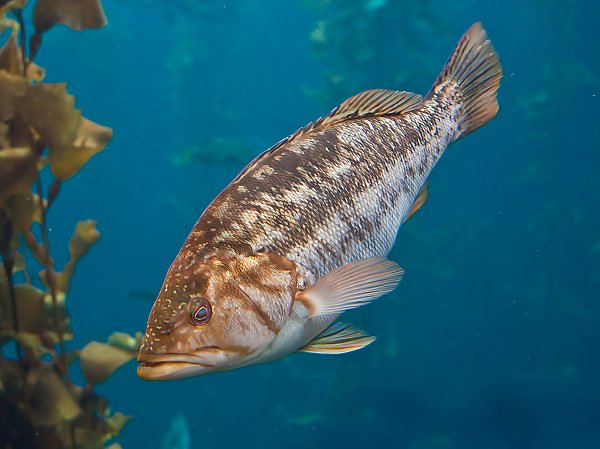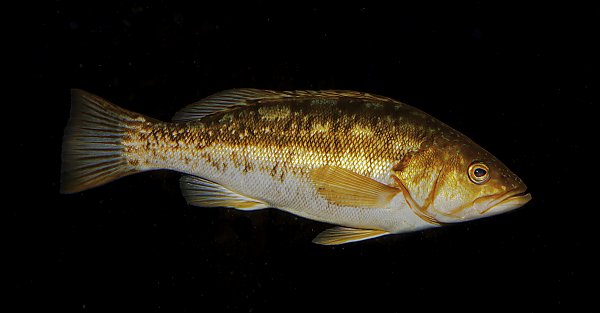Kelp Bass
Paralabrax clathratus
Kelp Bass
Paralabrax clathratus
Morphology
Kelp bass, also known as calico bass, have an elongated, relatively deep, and compressed body with a pointed snout and a large mouth. Juvenile kelp bass are light brown, while adults vary from brown to olive-green. The dorsal part of the head features light yellow spots, and the body is patterned with black, white, and/or olive-green blotches. Kelp bass can exhibit rapid temporary color changes during intraspecific (occuring within a species) interactions that include spawning and aggressive encounters. During spawning season males take on a golden to orange coloration on their snout. The species is also distinguished by multicolored spotting under the belly, which is why it is also called calico bass. Kelp bass can reach a maximum total length of 72 centimeters and a maximum weight of 7 kilograms.
Habitat and Range
Kelp bass are most commonly found south of Point Conception in California to Southern Baja California, Mexico. On rare occasions, they are observed as far north as the Columbia River in Washington. Kelp bass primarily reside in rocky reef and kelp forest habitats. They also favor structurally complex man-made structures such as piers, harbor breakwalls, and oil and gas platforms. These environments provide high vertical relief, shade, and shelter, which are crucial for their survival and predatory behavior. They prefer shallow waters ranging from 2 to 20 meters, but can be found to at least 50 meters deep.
Range Map

Reproductive Biology and Life History
Kelp bass are slow-growing – reaching sexual maturity at about 3 to 5 years of age and living up to 34 years. They are pelagic spawners, meaning they release their eggs into the open water column where fertilization occurs. They form breeding aggregations in the late spring and summer of tens to hundreds of fish. Spawning events typically occur in the late afternoon and evening, and involve a single female and typically between 5 to 15 males. These aggregations typically occur around structures such as kelp canopies, reef slopes, or man-made structures like piers. Males engage in various courtship behaviors, including positioning themselves perpendicularly to females, rolling from side to side, extending their dorsal fins, and rubbing against the female’s body. The female and multiple associated males release their gametes synchronously. After fertilization, eggs hatch into larvae within approximately 36 hours. The pelagic larval phase lasts for 28-30 days, during which most larvae will die, but for those that survive, currents can carry them over 100 km from where they were born. Females can spawn multiple times within a single breeding season.
Ecology
Kelp bass are opportunistic feeders, with a diet that varies by age. Juveniles primarily consume plankton and benthic invertebrates, while adults feed on fish and cephalopods (octopus, squid, and cuttlefish). Kelp bass possess sophisticated sensory systems that allow them to effectively navigate, hunt, and survive in their underwater environment. Specialized cells in their nostrils (or “nares”) detect chemical changes in the environment, aiding in activities such as locating food, identifying mates, and avoiding predators. They also rely on their lateral line sensory system, which enables them to detect movement, vibration, and pressure changes in the water. The lateral line consists of a series of pores and canals running along the sides of the fish’s body. These canals contain neuromasts, which are sensory organs composed of hair cells covered by a gelatinous cupula. This system is crucial for spatial awareness, allowing fish to sense their surroundings, detect prey, avoid predators, and maintain schooling behavior. Giant sea bass, whose population is currently depleted off the California coast, is the primary natural predator of adult kelp bass.
Cultural Importance and Historical Context
Kelp bass is a significant species in the recreational fishing industry, especially in Southern California. It is one of the most important recreational fisheries in the region, providing economic benefits through expenditures on fishing gear, licenses, and tourism associated with fishing trips. In Southern California, kelp bass are caught year-round but are most commonly fished during the summer months of June, July, and August during their spawning season. Kelp bass have ranked among the top ten species for recreational landings in California since 1980.
Date modified: January 2025
This animal can be found at the Aquarium of the Pacific
Primary ThreatsPrimary Threats Conditions
Threats and Conservation Status
Due to their popularity as a food and game fish, kelp bass populations have been subject to significant fishing pressure. Focusing on the South Coast region, which is where kelp bass primarily occur, data from the Marine Protected Area (MPA) monitoring network indicate a weak increase trend when combining MPA sites with reference sites. By separating MPA sites from reference sites the trends become clearer. In particular, kelp bass numbers are stable with fluctuation but not increasing in reference sites. In contrast, kelp bass sites within MPA’s show an almost 5% annual increase since 1999 (a strong increase trend) and that annual increase explains 42% of the year-to-year variation in kelp bass numbers.
Commercial fishing of kelp bass has been banned in California since 1953. This leaves recreational fishing as the major threat for kelp bass. Marine Protected Areas or MPA’s can reduce the chances for dangerous over-exploitation of marine species, by creating spatial refugia where no harvest is allowed. The graphs of kelp bass through time inside versus outside MPA’s provide evidence of the effectiveness of MPA’s when measured via tracking population dynamics.
In addition to the kelp bass being more abundant within MPAs, the protection from fishing results in the fish also being larger on average inside MPAs. The larger females produce more eggs when they reproduce, and once spawned and transported by currents, the baby kelp bass can settle outside of the MPAs helping to support the recreational fishery in the areas that remain open to fishing.
MPA’s would not be a sufficient conservation tool if they were the only approach available. They are supplemented with regulations on recreational fishing that for kelp bass take the form of bag limits, size limits and occasionally seasonal closures. Some recreational fishers also voluntarily catch and release larger kelp bass which may help to maintain the populations of the largest females that produce exponentially more eggs, further helping to support population stability. Finally, protecting and restoring kelp habitat is also essential because kelp bass recruitment is strongly correlated with giant kelp stipe density.
Population Plots



Data Source: Monitoring and Evaluation of Kelp Forest Ecosystems in the MLPA Marine Protected Area Network. California Ocean Protection Council Data Repository.


